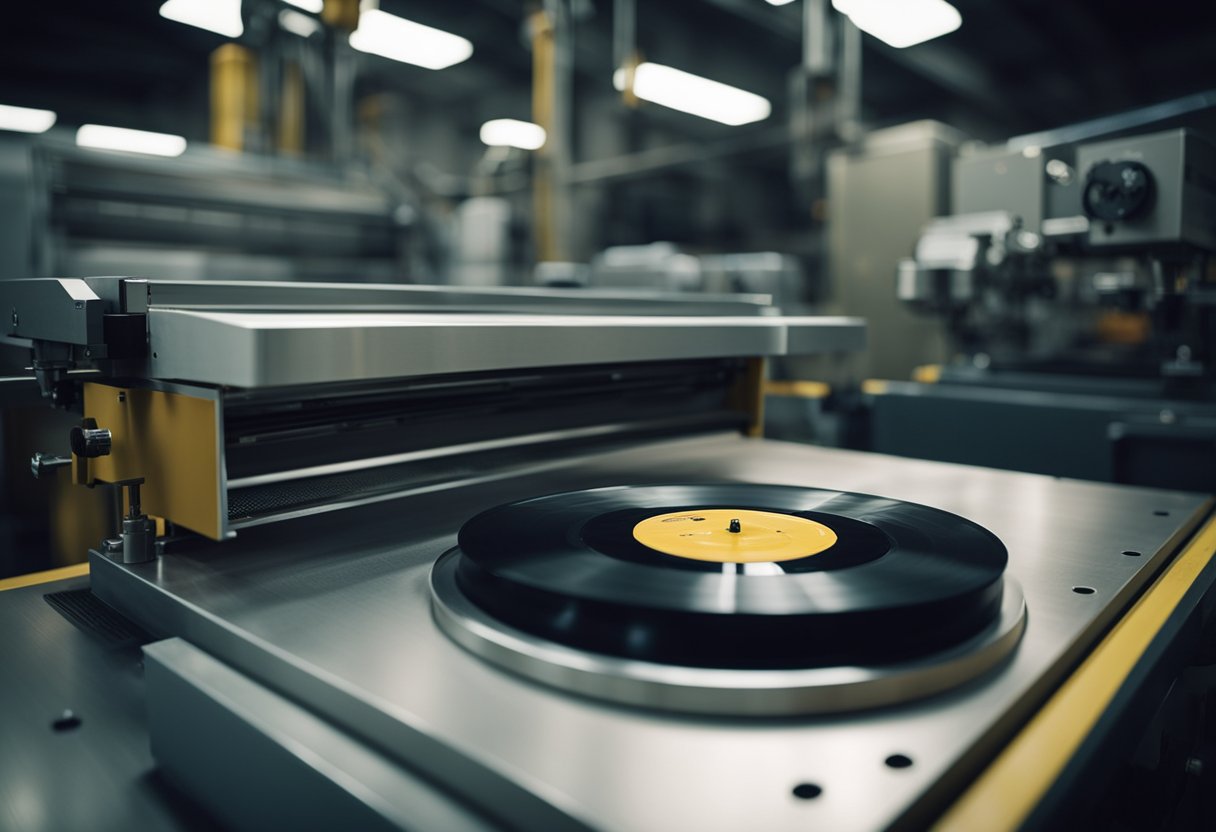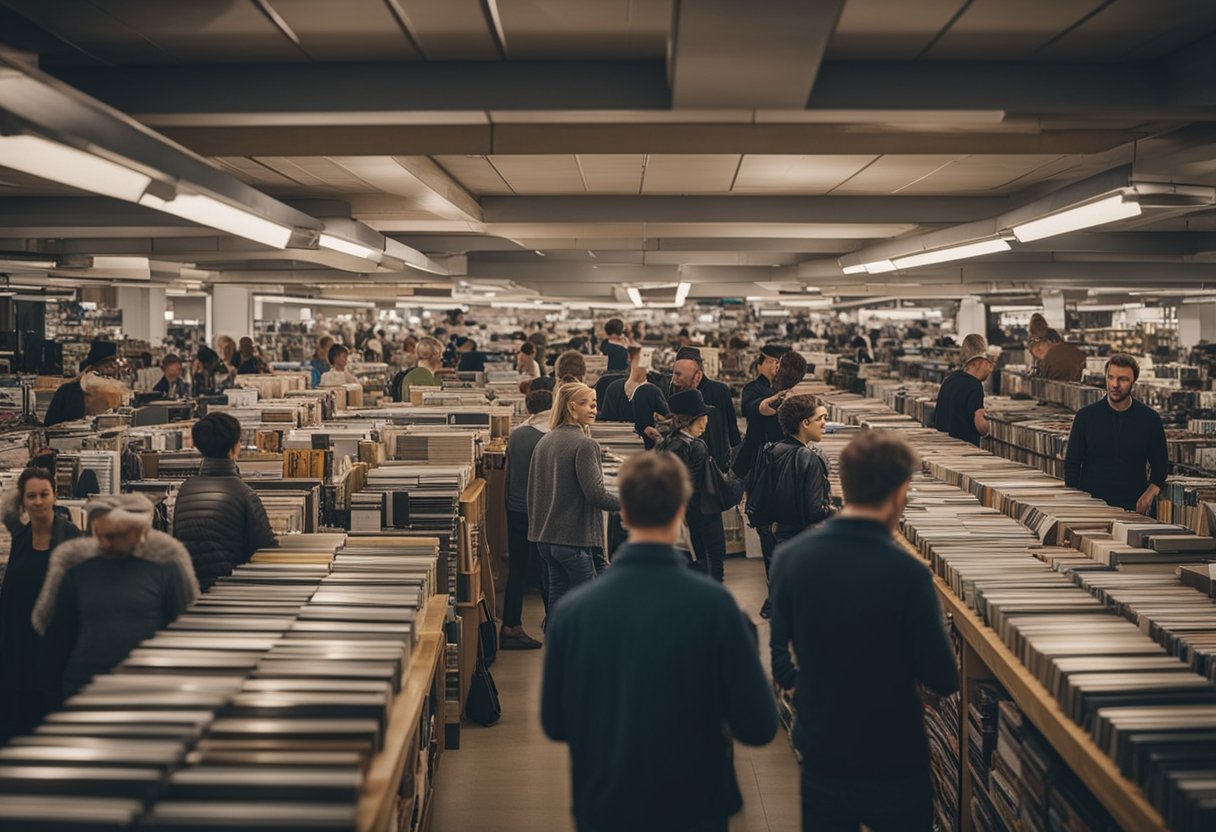The Global Revival of Vinyl: Charting the Resurgence of Physical Music Formats

Updated On: April 29, 2024 by Fatma Mohamed
Our exploration today will be throughout Revival of Vinyl! Music consumption has been irrevocably transformed by the digital revolution, reshaping not just how we access songs but also how we connect with the medium. Amidst this technological torrent, the vinyl record—once threatened with obsolescence—has experienced an astonishing renaissance. As we witness the global revival of vinyl, it becomes more than a mere retro trend; it’s a statement about the value of tangibility and tradition in an increasingly virtual world.

Vinyl’s resurgence is multifaceted, embodying a blend of nostalgia, superior audio quality, and the allure of physical collectability in contrast to the ephemeral nature of digital streaming. During times of uncertainty, such as the recent pandemic, vinyl has offered a sense of permanence and comfort. By choosing vinyl, consumers are participating in a cultural phenomenon that transcends music itself, embracing a deeper appreciation for artistic expression and supporting an entire industry built on craftsmanship and authenticity.
Table of Contents
Revival of Vinyl in a Digital Age
In our fast-paced digital world, where music is often a mere click away, we’re witnessing the striking resurgence of vinyl records. This revival highlights a compelling blend of technological nostalgia and the allure of tangible music experiences.
Vinyl Records Versus Digital Music
Vinyl records offer a deeply tactile and visual experience that digital files simply can’t replicate. When we place a vinyl record on a turntable, we’re not just queuing up tracks for passive listening; we’re actively participating in the playback of music. The physical interaction with the medium, from handling the record to dropping the needle, is as much a part of the experience as the music itself.
- Sound Quality: Many audiophiles argue that vinyl provides a warmer, richer sound compared to the compressed nature of digital music. While digital tracks are more accessible through streaming music platforms, they often lose some of the depth and texture present in analogue recordings.
- Collectability & Artwork: Vinyl albums often come with elaborate artwork and liner notes, turning each record into a collector’s item. The cover art and physical presence of vinyl give it a personal touch that a digital download can’t match.
Generational Nostalgia and the Appeal of Physical Formats
The draw of vinyl isn’t limited to just those who grew up with the format. We’re noticing a cross-generational pull towards vinyl; young listeners and older generations alike are seeking out the nostalgia and authenticity that come with owning physical formats.
- Nostalgia: For many, vinyl conjures up memories of a bygone era. It’s a sentimental journey for those who remember flipping through albums at a local record store or listening to a cherished LP with family and friends.
- Generational Influence: Younger generations are discovering vinyl through their parents’ collections or as they explore different ways of consuming music. To them, vinyl is a novel and exciting way to experience music that goes beyond passive listening from digital files on their devices.
Physical format isn’t just about the music; it’s about the experience. With vinyl, we’re not just listening; we’re engaging with music on a level that feels more personal and visceral. It’s a refreshing contrast in an age where digital abundance can sometimes lead to sensory overload. Vinyl allows us to slow down, appreciate the artwork, feel the record, and immerse ourselves in the listening experience.
The Artistic Value of Vinyl

The resurgence of vinyl records underscores their significant artistic value, from the tangible artwork to the immersive experience they offer.
Album Artwork and Liner Notes
The visual aspect of vinyl records plays a pivotal role in their allure. Album artwork is more than just a cover; it’s a key part of the artist’s expression and the listener’s experience. When unfolded, the larger canvas of vinyl jackets can reveal intricate designs, extensive illustrations, and sometimes, elaborate gatefold presentations that simply aren’t replicated in digital formats. Such artwork often becomes iconic, integral to the album’s identity.
Liner notes also contribute greatly to the artistic worth of vinyl. They provide insights directly from the artists, lyrics, acknowledgements, and sometimes stories behind the music. These liner notes help forge a genuine connection between the artist and the listener, adding a layer of authenticity to the listening experience that many enthusiasts of vinyl culture treasure.
The Aesthetics of Vinyl Culture
Vinyl culture is steeped in authenticity and aesthetics, nurturing a community that values the tactile engagement with music. Handling records, setting a turntable, and flipping sides are all part of an immersive ritual that vinyl records offer. The process celebrates the art of music as a deliberate and mindful activity, not just an auditory background to daily life.
The culture surrounding vinyl is characterised by a deep appreciation for the history and tradition of music as a physical medium. Collectors and aficionados value not just the sound quality but also the prestige of owning limited editions and rare pressings. This tangible aspect of music consumption adds a layer of artistry and connection that digital streaming services can’t match, making vinyl records a medium that engages fans beyond the music itself.
Technical Aspects of Vinyl Production

When it comes to vinyl production, there are several technical factors that directly influence the sound quality of the final LP. Understanding the specifics of how pressing plants operate and the impact they have on vinyl sound is crucial.
How Pressing Plants Influence Sound
Pressing plants are central to the vinyl manufacturing process, where the quality of an LP is heavily reliant upon precise technical procedures. In these facilities, sound quality is determined by a blend of art and science, with the outcome influenced by several technical aspects.
- Raw Materials: The type and quality of PVC compound used can affect the dynamic range and noise floor of records.
- Mastering: Different mastering techniques are used for vinyl, aiming to preserve the nuances of analogue sound while maximising dynamic range.
- Stamper Life: The condition of stampers—the metal parts that imprint the grooves—deteriorates with use, influencing sound clarity.
- Pressing Process: Pressing temperature, pressure applied, and cycle time play roles in how well the final product captures the nuances of the original recording.
- Quality Control: Scrutiny is essential at every step to minimise defects that could degrade audio fidelity.
By understanding these elements, we gain an appreciation for the complexities behind the cherished warm and rich sound of vinyl records.
Market Trends and Consumer Behaviour

In this era, vinyl record sales have soared, and the music industry has taken note of shifting consumer behaviour as fans oscillate between the tactile allure of physical media and the convenience of streaming services.
From Record Shop to Streaming Services
Once the cornerstone of music consumption, the record shop has faced significant challenges in the digital age. Nevertheless, a promising trend has emerged: vinyl sales have experienced remarkable growth, signalling a consumer appetite for tangible music formats. The resurgence of vinyl began taking shape around the 2006 mark, with sales in the U.S. alone growing by approximately 30% year-over-year. This is not merely a nostalgic wave but a clear indication of evolving consumer tastes favouring quality and collectability.
Streaming services now account for a majority of music industry revenue, with their convenience and accessibility being key drivers. Yet, they have also played a part in complementing vinyl sales by introducing younger audiences to a variety of music that they later choose to purchase in physical form.
The Role of Record Store Day
Record Store Day stands as an annual event celebrating independent record shops’ unique culture. By offering limited edition releases and attracting consumers back into stores, it has significantly contributed to vinyl’s continued revival. It’s an event that has not only increased vinyl record sales but also spotlighted the importance of physical media in a predominantly digital landscape. The event has been instrumental in drawing attention to the tangible aspect of musical enjoyment—reminding us why holding an album, with its artwork and liner notes, provides a different experience than clicking ‘play’ on a screen.
Our participation in Record Store Day and our support for local record shops underscore our commitment to both the health of the music industry and the cultivation of rich, consumer-driven experiences. The event has catalysed a broader appreciation for the vinyl format, and our collective buying behaviour has sent a clear message: the physical medium is an irreplaceable part of music’s ecosystem.
Artist Contributions to the Vinyl Movement
Our exploration begins with the significant impact artists have had on the vinyl resurgence. Their releases and continued support have undeniably ignited renewed interest in this classic format.
Modern Artists and Vinyl Releases
In recent years, modern artists have played a pivotal role in the vinyl revival by releasing their latest albums on wax. Harry Styles, for instance, has captivated a younger generation of vinyl enthusiasts with his album Fine Line, making it a collectible item. Taylor Swift has also contributed significantly, offering limited-edition vinyl pressings of her albums, such as Folklore, that have become highly sought after.
Adele’s album 25 echoes this trend, releasing collector editions that have ensured the vinyl format remains relevant in contemporary music culture. These modern artists releasing on vinyl bridge the gap between past and present, bringing the tangible quality of music back to life for new audiences.
Iconic Musicians and Enduring Influence
The vinyl movement owes much to iconic musicians whose works continue to be celebrated and sought after on vinyl. The Beatles’ profound influence on music history is encapsulated in their extensive vinyl discography, which remains a staple for collectors and fans.
Fleetwood Mac’s album Rumours is another beacon of this enduring influence, with its timeless appeal ensuring its continued presence in vinyl collections across the globe. Liam Gallagher, both as a solo artist and in his days with Oasis, regularly presses his new releases to vinyl, showing that the legacy of iconic musicians not only lives on through their classic records but is also carried forward with new music embraced by vinyl enthusiasts.
Vinyl as a Cultural Phenomenon
The global resurgence of vinyl records is not just a niche trend but a vibrant cultural phenomenon that transcends generations and fuels social connectivity through music.
Generational Crossover in Vinyl Adoption
The vinyl revival is marked by a significant generational crossover. While baby boomers and Gen Xers may be revisiting their old collections, millennials and Gen Z have become ardent supporters of the medium. This unique blend of demographics finds common ground in the tactile and authentic experience vinyl offers. Despite living in a digital age, younger generations are drawn to vinyl for its richer sound quality and the deep sense of ownership it provides. In an era of ephemeral media, the permanence of a vinyl record holds a special allure for those who wish to physically possess their music.
Vinyl Collecting as a Social Activity
Collecting vinyl has evolved into a robust social activity that weaves together communities of enthusiasts. Vinyl culture doesn’t only thrive in online spaces; record shops serve as social hubs for record collectors to meet, exchange knowledge, and share their passion. Beyond the individual pleasure of amassing records, the joy of vinyl collecting often lies in the shared experience, whether that’s through digging for hidden gems at a local store or attending vinyl-centric events. Here, collectors of all ages gather, discuss their favorite records, and celebrate the artistry encapsulated in every groove.
By focusing on specific collectibles or artists, vinyl as a physical medium promotes interaction, connection, and understanding across age groups, reinforcing the notion that music—and its mediums—can indeed be timeless and universal.
The Industry Behind the Revival
In tracing the resurgence of vinyl, it’s crucial to understand the mechanisms and players of the industry that have fuelled this revival. The record labels, both major and indie, alongside the Recording Industry Association of America (RIAA), have played instrumental roles in steering this resurgence.
The Role of Major and Independent Record Labels
Across the music business spectrum, major record labels have brought significant financial and marketing resources to bear, reissuing classic albums on vinyl and promoting new releases in the format. Coupled with their extensive distribution networks, they’ve been pivotal in vinyl’s renewed availability in mainstream outlets.
Contrastingly, independent record labels have nurtured the vinyl market by catering to niche audiences, often releasing limited edition pressings and special versions of albums that appeal to collectors. These labels are passionate proponents of the tangible aspects of music consumption, and their dedication has triggered a broader market interest.
The recording industry associations, specifically the RIAA in the United States, track and certify sales figures, providing valuable data that evidences the format’s increased popularity. Their statistics have shown consistent year-over-year growth in vinyl sales, validating the format’s economic viability and its place in the music industry once again.
These entities have not only contributed to the resurgence of vinyl through their business strategies but also by fostering a culture that appreciates the physical medium. As the physical counterpart to the digital listening experience, vinyl offers a tangible connection to music that is cherished by many.
Global Perspectives on Vinyl’s Popularity
Vinyl’s resurgence as a beloved musical format has taken a notable turn, with sales and interest increasing across the globe. This resurgence is not a mere trend, but a portrayal of vinyl’s timeless appeal and growing significance in the digital age.
The UK’s Place in Vinyl’s Resurgence
In the UK, there’s been a significant upswing in vinyl record sales. The British Phonographic Industry (BPI) reports a continuance in the growth of vinyl, with numbers reminiscent of the medium’s golden years. Not only does this indicate a nostalgic reconnection to tangible music forms, but also a cultural movement valuing the artisanal aspect of vinyl, befitting the global trend.
Vinyl Revival Across Different Regions
Moving beyond the UK, the vinyl revival is a global phenomenon. Regions such as North America and parts of Asia are also seeing a remarkable boost. In the United States, the Recording Industry Association of America (RIAA) illustrates a soaring trajectory for vinyl, with sales surpassing those of other traditional formats. It’s a conjuncture revealing the universal nature of vinyl’s allure – one that transcends cultures and age groups, uniting varied audiences in appreciation of the medium’s unique acoustic and aesthetic qualities.
Physical Media in the Era of Convenience

In this fast-paced digital world, we find that vinyl records, cassettes, and compact discs offer a tangible connection to music that is often lost with digital downloads and streaming services.
Comparing Vinyl to CDs and Cassettes
Vinyl records, known as LPs, provide a unique auditory experience with a warmth and depth of sound that aficionados highly value. The resurgence of vinyl has been significant, as it offers not only superior audio fidelity to die-hard enthusiasts but also a collectable aspect with its artwork and liner notes.
Cassettes have a vintage charm that has been embraced by niche markets. They offer a sense of nostalgia and, while their sound quality does not match that of vinyl or CDs, they provide a snapshot of a bygone era.
Compact Discs (CDs) struck a balance between sound quality and convenience, once hailed as the definitive way to experience music. Their digital nature meant no background noise and greater durability than their analog counterparts.
Despite the convenience of streaming services and the practicality of digital downloads, these physical formats have weathered the storm of technological advancement, each finding a place in the hearts of music lovers around the world.
Analysing Vinyl’s Audio Quality
In this section, we’ll explore the intricacies of vinyl’s audio reproduction, discussing how it compares to digital formats and what aficionados of music perceive in its sound.
The Warmth of Analog and the Clarity of Digital
Many vinyl enthusiasts admire the medium for what is often described as a warmer and more natural sound compared to digital recordings. This warmth is typically attributed to the analog nature of vinyl sound, which can more accurately represent the original audio waveforms. Vinyl records literally encode music in a series of grooves on the disc; when a turntable’s needle—also known as a stylus—runs through these grooves, the vibrations are transformed into sound, which many audiophiles argue has a richness and depth that digital formats might lack.
However, one might note that some imperfections—such as pops, crackles, or hisses—are occasionally present in vinyl playback. These imperfections are often considered part of the vinyl experience, adding to the tactile and aural nostalgia that characterises the format. Yet, these noises are not typically intrusive, especially on well-maintained turntables and with records in good condition.
Digital streaming, on the other hand, presents audio with a clarity and precision that is difficult to match in physical formats. With digital, the sound quality is consistent and free from the surface noise inherent to vinyl. Moreover, the convenience and portability of digital music have redefined our listening habits, allowing us to access vast libraries of music wherever we go.
While both formats have their merits, it’s the distinctive sonic character of vinyl records, along with the tactile engagement of using turntables, that continues to endear them to many music lovers around the world.
The Future of Vinyl and Music Consumption
As we explore the resurgence of vinyl, it’s important to note the anticipated growth and continued appeal of this beloved format. Vinyl records have made a significant comeback, with sales flourishing in a market dominated by digital streaming services. This intersection of traditional and modern music consumption underscores the vinyl revival, showing its capability to coexist with streaming platforms. The focus now shifts to how vinyl production can adapt to sustainability challenges while meeting the increasing demand.
Sustainability and Innovation in Vinyl Production
In the wake of the vinyl revival, manufacturers are now considering the sustainability of their products. Innovations within the industry are aiming to reduce the environmental impact of vinyl record production, which includes finding alternatives to PVC, the traditional raw material used that has raised ecological concerns due to its non-biodegradability.
Bold steps towards sustainable practices in manufacturing might incorporate recycled materials, and the adoption of novel ecological materials could signal a turnaround time for pressing records, balancing demand with environmental responsibility. These measures not only serve the planet but also appeal to the values of a growing eco-conscious consumer base.
Aligning with the vinyl resurgence, we’re witnessing a shift in music consumption habits. Physical mediums now serve a dual purpose: they offer a unique listening experience and act as collectors’ items, fostering preservation of music in tangible form.
Streaming services, on the other hand, continue to provide convenience and accessibility. Yet, they also contribute to the narrative that bolsters vinyl’s popularity by spotlighting the tactile and auditory richness that digital formats might lack.
In conclusion, the future of vinyl is both nostalgic and forward-thinking, embracing tradition while heralding a new era of innovation and mindful production.
Frequently Asked Questions
In this section, we tackle the most common queries surrounding the remarkable return of vinyl records to prominence in the music industry.
What has prompted the resurgence of vinyl records in recent years?
The revival of vinyl records is driven by a nostalgia for physical media and the tactile experience it provides. A resurgence of interest in vinyl has grown steadily since 2006.
In which year did vinyl records witness a significant resurgence in sales?
Vinyl records experienced a major resurgence in sales starting from 2006 with a consistent increase in demand each year, as music enthusiasts began to value the tangible connection to music that vinyl offers.
What are the reasons behind vinyl’s popularity among music enthusiasts today?
Vinyl’s popularity can be attributed to the unique sound quality, large artwork, and the collectability of records. People enjoy the ritual of playing vinyl and the analogue experience it offers in a digital world.
How do vinyl record sales in 2023 compare with previous years?
In 2023, vinyl record sales continued to rise, showing a consistent upward trend when compared to previous years. This reflects a sustained and growing interest in the vinyl format.
Can the sustained interest in vinyl records be considered a temporary trend?
Given the long-term growth in vinyl sales and the deep-rooted cultural affection for the medium, this resurgence does not seem to be a temporary trend. Instead, it is an ongoing interest redefining the music industry.
What is the projected future for vinyl records in the ever-evolving music industry?
The projected future for vinyl records is promising with the format expected to remain an important part of the music industry. Current trends indicate a vibrant market for new releases, reissues, and special editions that cater to both collectors and new audiences.






